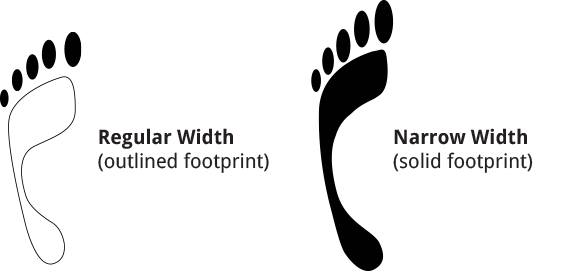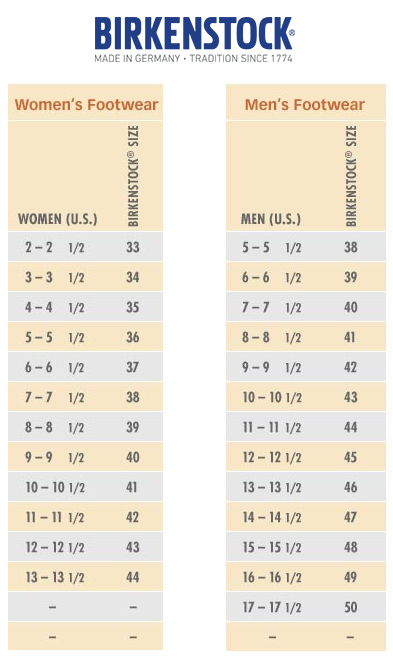Birkenstock sandals are still made in Germany and thus uses European sizing. European sizes are "unisex" (one size for both women and men) whereas USA sizes are different for women and men. For example; a Birkenstock Arizona Sandal size 38 M EU equals a 7 to 7.5 for a US Woman, or, a 5 to 5.5 for US Men.
The helpful notes and the size conversion charts below form a general guideline to help determine your size. In our experience of Birkenstock this is a good guide for fitting in relation to US customers. However your exact size will ultimately depend on the structure of your individual foot and the style of the shoe. Please note that the new Birkenstock shoe boxes (shown below) have a slightly different conversion chart. Whilst it is an official chart from Birkenstock the manufacturer, we feel our guide is more appropriate in our experience with US customers.
1. Birkenstock Regular vs Narrow

Outlined footprints indicate a regular fit footbed and a solid/filled in footprint indicating a narrow fit footbed.
Have regular or wide feet? Stick with a size "M" which is for regular/normal feet.
Have regular to wide feet (or are you a fashionista)? Stick with a size "N" which is for both regular/skinny feet.

2. Birkenstock Shoe Length:
Yes, we hear you. Birkenstocks are generously sized compared to other sandals. But remember, these are foremost orthopedic sandals and are made to fit roomy. If you are a fashionista and do not care about comfort, by all means, go down 1 (one) size. But remember, Birks are designed to fit the three arches of your feet: The medial arch (the largest arch typically referred to in the phrase "good arch support"), the metatarsal arch (the pocket between the ball of your foot and your pinkie toe), and the lateral arch ( a lesser known structure on the outside of your foot, in front of your heel). Because the Birkenstock flexes, at the cost of room at the ends of the footbed, a properly sized fit includes some extra room in front of the toes and behind the heel (in a normally-proportioned foot). This maintains correct support under your arches, providing a dynamic balance while you walk.
Damage to the foot is a common health problem in today's population. A large portion of the symptoms are provoked by ill-fitting footwear, and so it is important that you get the correct size/fit. If you make sure you get the correct size by following our sizing guide and our fitting tips when purchasing your Birkenstocks, you will extend the life of your sandals tremendously and enjoy them a lot more. Always try on, and break in, your shoes indoors on carpet before wearing them outside! The contours of the footbed should follow the curves of your foot. The raised arch might feel unusual at first, but the arch support will feel less pronounced as the cork/latex footbed moulds to your foot. Even with foot health sandals the right fit is important. Therefore the Original Birkenstock foot bed is manufactured in two widths. When purchasing your Birkenstock sandals, ensure that you get the correct width. Regular or Narrow Birkenstocks are designed to be roomy. When you first try your sandals they might feel big. Most people are fine with a regular fitting, but if your foot moves side to side when you walk and adjusting the strap does not help, a narrow fitting may be more suitable. To check the width of a pair of Birkenstocks you already own, you can tell by inspecting the foot bed where there is a small image of a foot. If it's filled in the shoe is a narrow fitting, and if it's an outline it's regular. When fitting sandals, the strap closest to your toes should fit comfortably, but not tight. The other straps should be more loose fitting to allow your heel to lift slightly off the footbed while walking. Birkenstocks should never be worn with the straps buckled tight.
3. Birkenstock Size Chart - please see the different column for either Men or Women

4. How to read a Birkenstock print on the footsole

Above:
1) Foot symbol is filled-in/solid indicating that this is a size "N" for narrow/skinny feet.
2) The European size 38 which corresponds to a 7 to 7.5 for a US Women.
3) Material of the footbed (leather); please note that this not indicate the upper material (it may be different).
5. Just to clarify the Birkenstock Shoe Width:
Yes, Birkenstocks are wide for the same purpose as described above. Birkenstocks passively support the architecture of your feet from underneath, just as your bare foot would be supported walking on a complient surface like earth or sand. Conventional shoes support your foot by binding them, rendering them less mobile. Your foot is a dynamic structure that NEEDS to move, in order to function correctly. If you do not like wide sandals, select a size N = Narrow Fit.
6. Break-In Period for standard Birkenstock cork footbeds (not for softfootbed):
3) They require a break-in period: Birkenstock sandals are firm under the sole of your foot. The footbed molds to the individual shape of YOUR feet over time, providing an even support across the entirety of your foot. Conventional shoes accomodate the hard points on the soles of your feet with padding that squshes under pressure, but doesn't actually support the structures of your feet. Birkenstocks are WALKING shoes, and after a normal breaking-in period, you should be expect to comfortably walk MILES in them. We suggest to walk them for an hour around the house during the first couple of weeks after you receive them. This will help to break them in!
Birkenstock footwear works by supporting your arches, reducing the strain on the muscles of the foot. When you try on your first pair of Birkenstock shoes, take time to walk around indoors and get used to them. You should break them in gradually. Your feet should fit completely inside the footbeds, with 1/8 to 1/4 inch of extra length for walking. The width should fit closely to prevent your foot from slipping side to side. If your toes have become curled from wearing tight shoes, make sure your Birkenstocks are long enough to accommodate them once they have resumed their natural shape. The Birkenstock footbed is contoured to match the shape of a healthy foot. Because few people have perfectly shaped feet, new shoes may feel "different". The toe grips should be in the right place for your feet and some wearers find the arch support can feel prominent initially. If you have worn high heels for years, your Achilles tendons may have contracted. Our footwear can help to restore their natural length. Birkenstock footwear is meant to be worn comfortably; the support comes from the footbed, not from tightly buckled straps. It may take several days to become used to the feeling, but your toes will soon learn to grip the footbeds as you walk. Although the footbeds may feel stiff at first, as you wear your Birkenstocks, the footbeds will become softer and more flexible. Soon your shoes will adjust to the shape of your feet, and form a truly unique fit that, properly cared for, will provide you with years of long-lasting comfort.
 |
| this is a NARROW size (N) - please take a closer look at the foot symbol which is "filled in" indicating that is is made for narrow/skinny feet. |
Birkenstock New Design (introduced in Spring 2016 in German market, Summer 2016 USA)
Addendum (08/27/2016). Birkenstock is upgrading their shoe box design to blue instead of white (this new blue shoe box design features a handy size measuring guide printed on inside of shoe box). The new blue Birkenstock shoe box is here to stay and for good reason! As most of you already know, Birkenstocks notoriously run about half a size large (they are still foremost orthopedic sandals which is why we love them in the first place) and this new feet measuring guide (printed on the inside of the new shoe box) will partially solve the sizing challenges associated with Birks.
I am a man with EEE in the USA. The M does not come close to fitting me. Your W used to. Do you still make W? If not, why not?
ReplyDeleteI think I may be 8 1/2 have purchased 3 pair of 9 or 40 but I wonder if next time I should get a 39 because of extr length.
ReplyDeleteI am on my feet all day doing hair and have horrible time with my feet... do you have a suggestion on the 39
Thanks for such a nice content. Apppreciate it :)
ReplyDeleteCheers
If anyone interested similar one's have a look here https:// theshoesfinder.com thanks